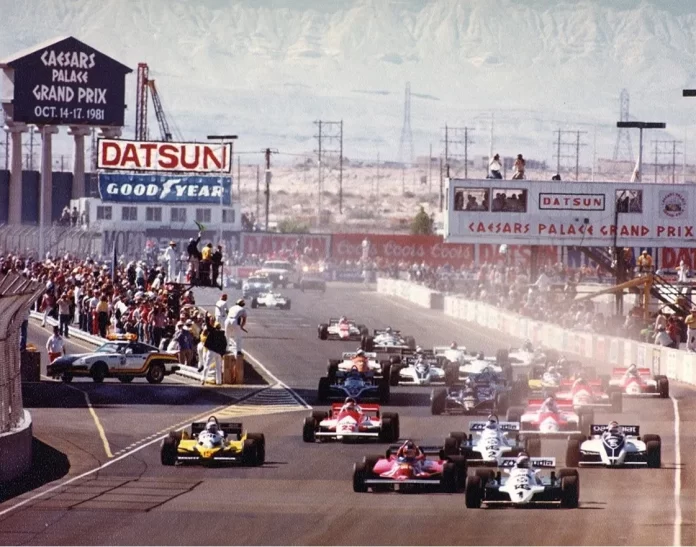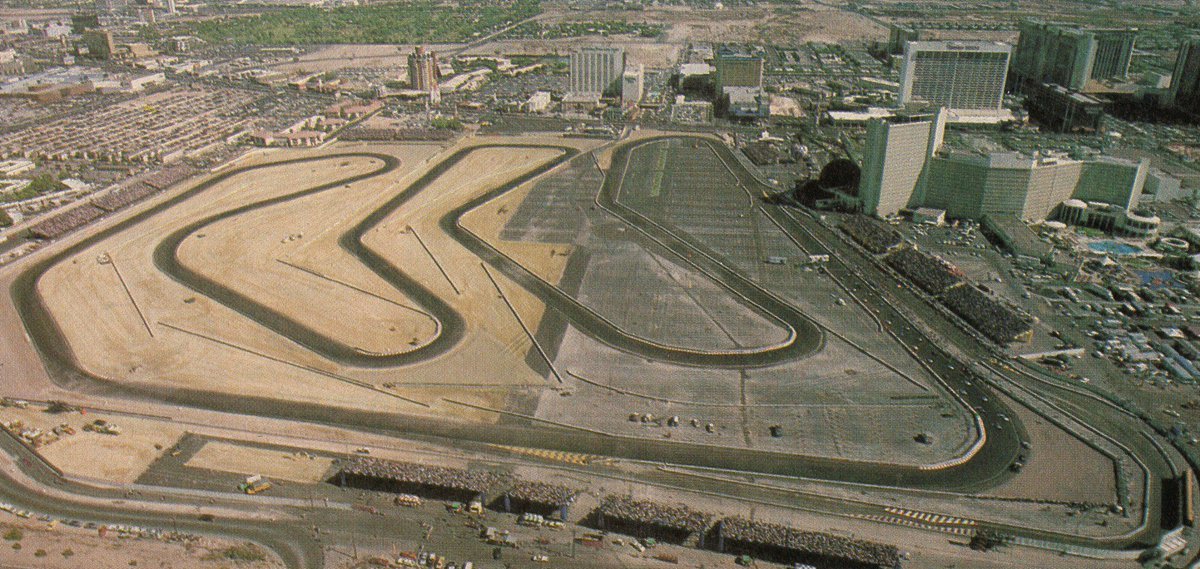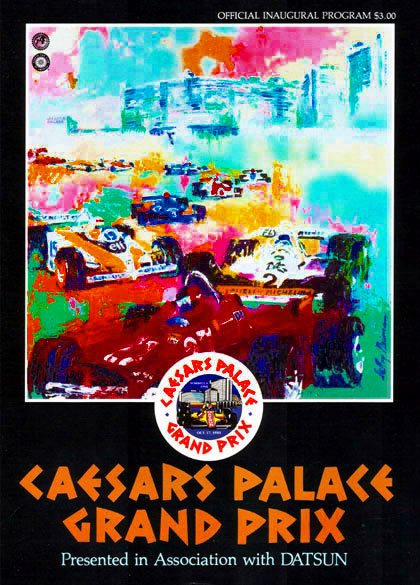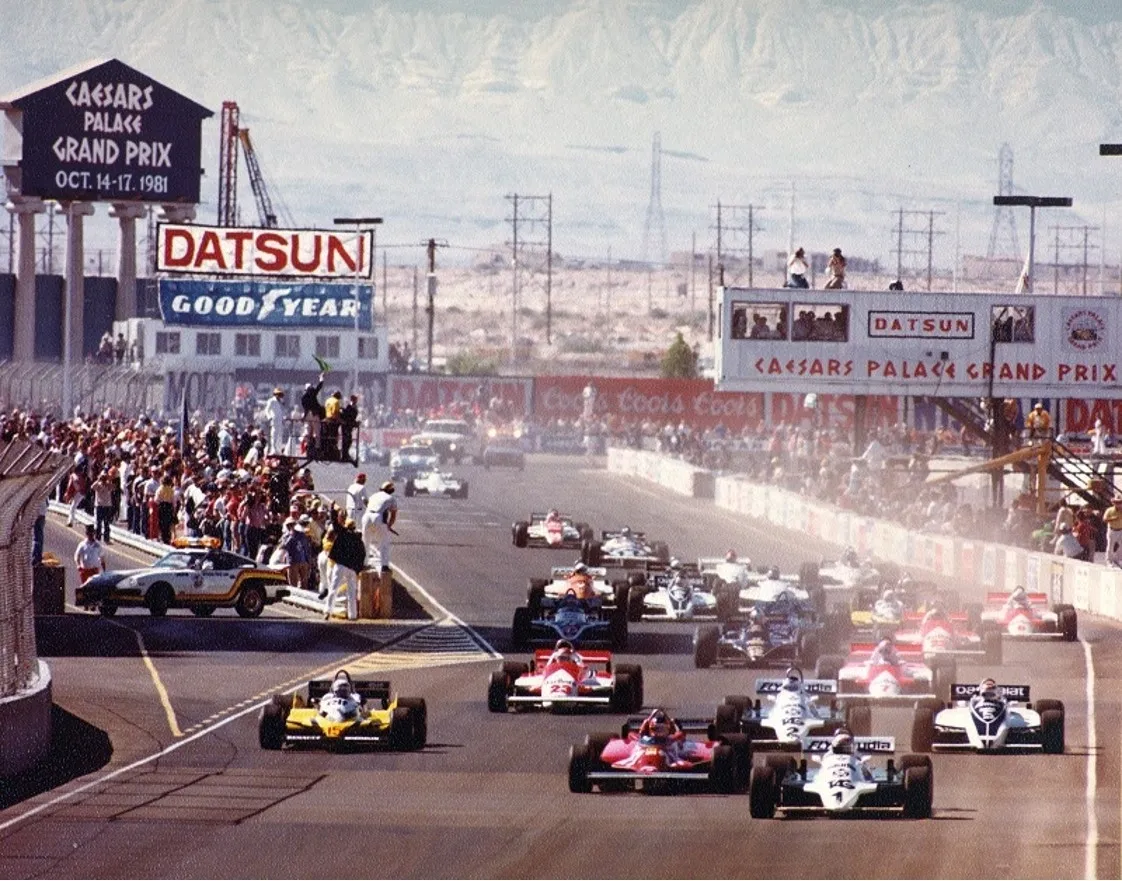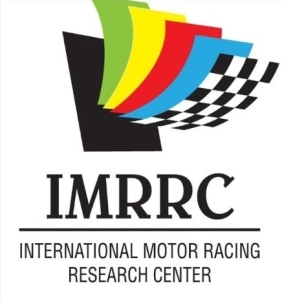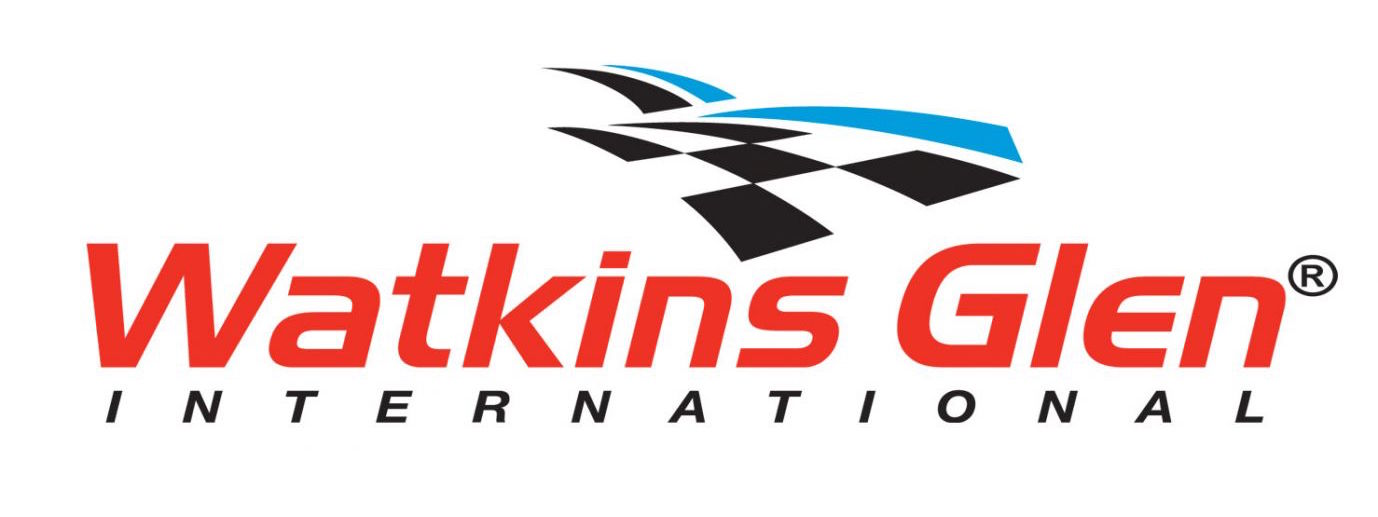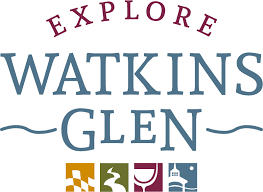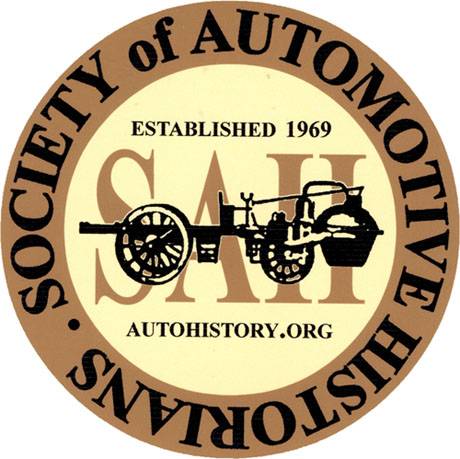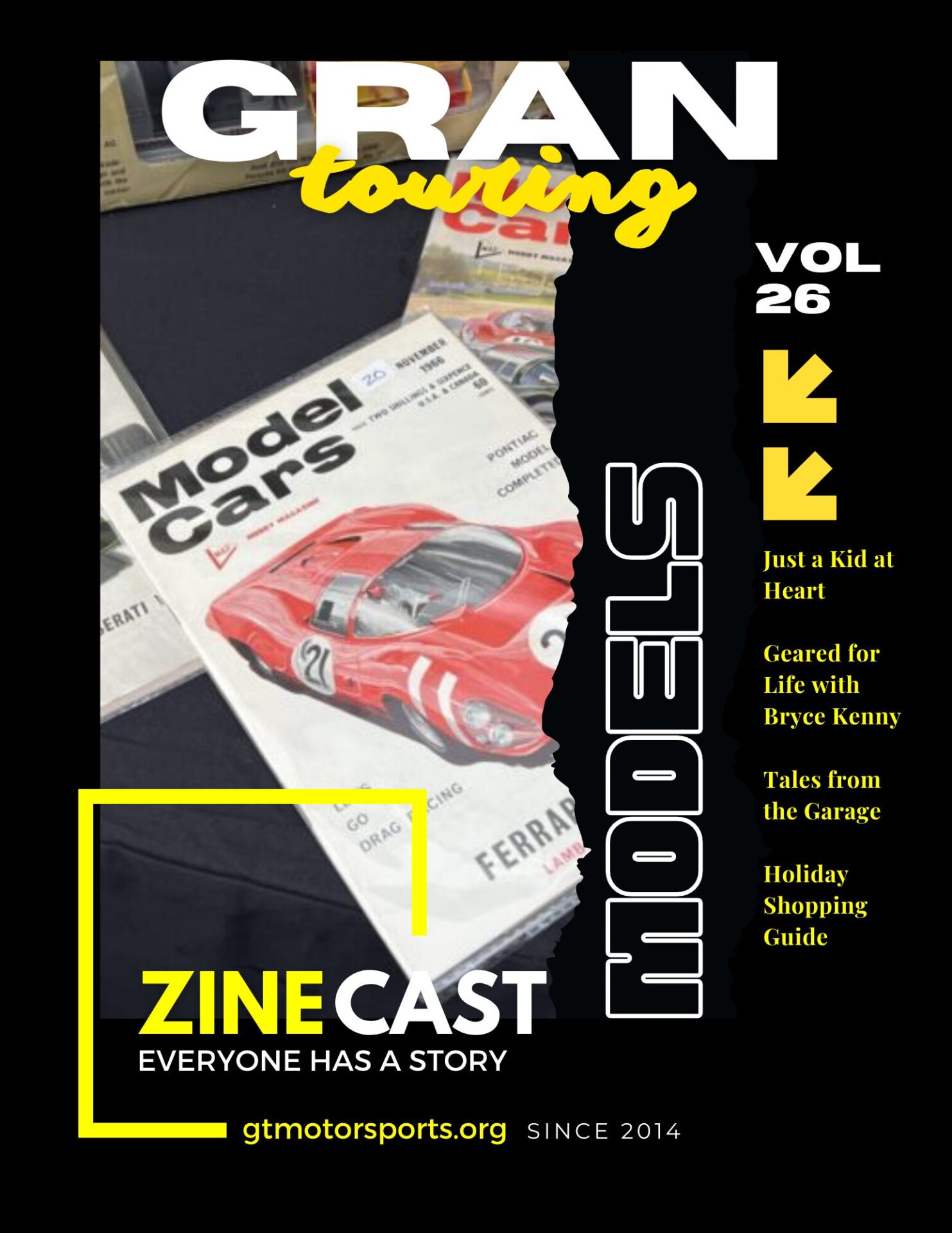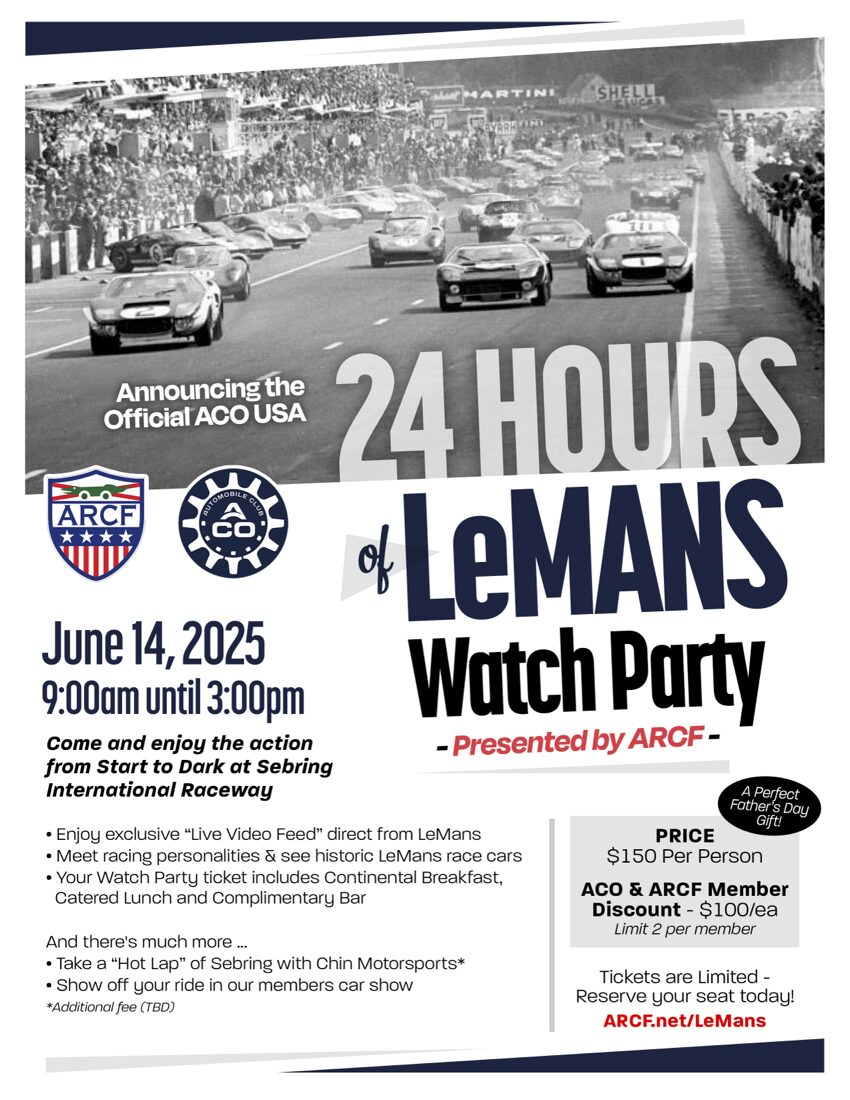[00:00:00] Break/Fix’s History of Motorsports series is brought to you in part by the International Motor Racing Research Center, as well as the Society of Automotive Historians, the Watkins Glen Area Chamber of Commerce, and the Argettsinger family. The Caesar’s Palace Grand Prix by Randy Cannon. Randall Cannon is a freelance journalist and author.
His first book, Stardust International Raceway, explored the convergence of organized crime and influences and motorsports interests in the international capital of legalized gambling, Las Vegas, Nevada. Cannon’s current offering, Caesar’s Palace Grand Prix, drills even more deeply into that nexus while also tracing the threads of history that culminated in the only Formula One events to date in that unique city.
Mr. Cannon will present from that research as well as the incremental steps forward from Caesar’s Palace that will result in the return of Formula One to the destination mecca of gambling in the 2023 Las Vegas Grand Prix. [00:01:00] All right, we’re starting off with Caesar’s Palace Grand Prix by Randy Cannon, who’s joining us.
via zoom from Reno, Nevada. Good morning attendees. It’s my honor to be here for the sixth Michael R. R. Getzinger symposium for international motor racing history. I’m going to talk to you this morning about my current book, Caesar’s palace Grand Prix, as Bob introduced the subtitle is Las Vegas organized crime and the pinnacle of motor sport.
I’m going to walk you through my approach to the research, some of the threads of history that culminated in the Caesar’s palace Grand Prix. And then we’ll connect a few dots forward to the return of Formula One to Las Vegas next year after a 40 year absence for the 2023 Las Vegas Grand Prix. I jumped into this project by going back to my original programs.
I did get to attend the 81 82 Formula One events and the 1983 HART IndyCar event. I kind of wanted to see what players, what actors I had to work with for the thesis as I wanted to develop it. I started with Cliff Perlman. I [00:02:00] remember him from my youth in Las Vegas. He certainly had alleged organized crime connections, most notably to the, uh, financial kingpin of the organized crime syndicate at the time, Meyer Lansky and alleged heir apparent to Meyer Lansky, a fellow named Alvin Melnick, who was actually still with us.
He was mentioned on the infamous Abscam reportings of the late 70s, as were Lansky and Melnick and Caesars Palace. He was the chairman of the board of Caesars Palace at the time of the 1981 Formula One event, and was the CEO of the parent corporation Caesars World. Next I saw Harry World. He was an original 1966 investor in the development and setup of the Caesars Palace Resort, a gambling licensee, a very shadowy background.
At the time of the first Formula One event, he was the CEO of Caesars Palace. He was a fixture on the Caesars Palace campus for nearly two decades. This one caught me off guard. I had no recollection of this from the time period, but Chris Pook is there in the program, the founder of the Long Beach Grand Prix Association and the Long Beach Grand Prix itself.
[00:03:00] He was the Grand Prix consultant for the Caesars Palace events, first three at least, and was very involved in the development of the program and the operations of the event. Now at the bottom here, really an interesting aside, Dr. Jeffrey MacDonald, convicted fatal vision murderer for those who remember the book and movie of the same name.
He was the Caesars Palace Grand Prix medical consultant. He had the same role for the Long Reef Shroud Creek. I had a chance to meet William D. Weinberger, Bill Weinberger, the son of William S. Weinberger, a very prominent Cleveland family, came out to Las Vegas to work at Gambling Operations. I got to meet Bill, interviewed him extensively, and he was extremely generous, sharing his recollections of the events, including his interactions with Bernie Egglestone, just a very nice, honorable man.
He was the vice president of casino marketing. The Formula One Grand Prix events were organized by Bill and flowed completely from his desk. I kind of focused on Cliff Perlman and Harry Walden. I wanted to see just how visible they were at the, uh, Formula One events. And they were [00:04:00] very visible right there on the podium.
Cliff Perlman kind of front and center along with his Meyer Lansky and Alvin Malinick connections. And there’s Harry Walden with his shadowy background up there. Along with Alan Jones, the winner of the 1981 Cedars Palace Grand Prix. He was the departing Formula One World Champion, driving for the Frank Williams team.
Alain Prost was second for Romeau. Bruno Giacomelli kind of tucked back in there. I enjoyed researching Bruno. He finished third, the only podium of his Formula One career. He was strided for the Alfa Romeo team alongside Mario Andretti in 1981. And Mario’s Wimbledon kind of forms his own thread of history.
True. As Formula One travels through America and on to the Caesar’s Palace Grand Prix. From there, I kind of took three overlapping circles, Venn diagram approach to the research. I knew I had a Las Vegas story. I did not yet know what the national and international connections of this story would be, but there were many.
I knew I was dealing with aspects of organized crime. Certainly in the Backstory of the development of the Caesars Palace property, but there were [00:05:00] many and they ran all the way through to the writing of the events by way of Click Perlman and his connections. And ultimately I knew I had an F1 story, the pinnacle of motorsport, and so at the sweet spot, the overlap of the circles, that’s where I developed the story of the Caesars Palace Grand Prix.
Both the organized crime thread and the Formula One thread start in the immediate post World War II period. This photo should be somewhat familiar to this audience, certainly the symposium organizers. The October 1948 American Grand Prix at Watkins Glen. I call it the American Grand Prix because the press called it the American Grand Prix.
Also known as the Watkins Glen Grand Prix, the history of Formula One blows forward from this day, the history of Formula One in America, and I thank the IMRRC for the use of this image as well as several others throughout the book. On the organized crimes side of the show, the story starts out similarly in the immediate post World War II period.
This is Meyer Lansky. He was roughly number three in the strata of the National Organized Crime Syndicate after Charles Lucky Mucciano and Don Vito Genovese. His alleged heir apparent was [00:06:00] Alvin Melnick, who we will visit a little bit later. Very close alleged connections to Cliff Perlman. It was the foot soldiers of Meyer Lansky and of Don Vito Genovese that developed and financed Caesar’s Palace.
The quote here is instructive. I took it to further my research into gambling operations around the world, including where Bernie Ecclestone applied his gambling pensions, at Crockford’s in the major gambling district of London, and indeed Meyer Lansky had his hands in all of them. I really enjoyed following the path of Formula One through America and the early influencers.
Alec Holman was the organizer of the 1959 1960 Formula One Grand Prix in America, here at Sebring the 1st, 1959, a very young where Bruce McLaren, Jack Brabham, was the world champion. Moving on to 1960 in Riverside, Alec Ullman was once again the organizer, Jack Brabham in the lead here. A bet was won by Sterling Moss.
I started to find organized crime connections in places I did not think I would find them. The then owner of [00:07:00] Riverside Raceway owner, President Roy Jean Lewis, prominent Mercedes dealer in the Southland. He had organized crime connections and got involved in Teamsters, financed property development, brought in that property development, sent him to prison.
He also had gambling connections in Nevada. Connections that would lead directly to Caesar’s Palace. Pretty fascinating bit of research for me there. Alan Goldman organized the first two Formula One Grands Prix in America. The next 20 were organized and presented by the Watkins Glen Grand Prix Corporation.
I really enjoyed this body of research. This is the 1961 event won by Ennis Ireland. I believe it was his only one of his Formula One career. Here we see Sterling Moss in the number seven vehicle, the Lotus Climax and beyond him. We see Bruce McLaren in the number two Cooper Climax. A long time honored run of Formula One, but the 20 year run of Formula One at Watkins Glen also spelled the transition to Caesars Palace, which is an integral part[00:08:00]
of the early safety and security director Charles Kress, that turned into an organized crime thread if you will. In 1957 there was a very famous, infamous I should say, mafia gathering at Appalachian, at the home of Joseph Barbera. And Charles Kress, the safety director for the Watkins Glouros Precorporation, had investigated Joseph Barbera for murder back in Kress’s law enforcement career.
And at the time of that 1957 Mafia gathering in Appalachian, he became extremely vocal about the rise of Mafia in the eastern states. Very vocal in his concerns to Governor Ehrman at the time. Formula 1 at Watkins Glen came to an end in 1980. Here’s Mario Andretti, his last year with the Lotus team. Just beyond him is the eccentric and somewhat criminal himself, David Thieme, the Essex sponsor of the Lotus team, cheering Mario Andretti on.
And beyond him, you can see Colin Chapman. Again, Mario Andretti kind of forms his own thread throughout the story. And I’ll talk about him a little bit later. Part of my research, I dug deeply into the files of the [00:09:00] Federal Bureau of Investigation, Securities and Exchange Commission. Every organized crime commission I could get my hands on.
This was a really instructive document here. The FBI documents, one of the Meyer Lansky foot soldiers, Jerome Zerowitz, and his positioning in the development of Caesar’s palace. He mentions a couple of other fellows, Vincent, Jimmy blue eyes, Aloe, and Anthony fat, Tony Solero. Of the Don Vito Genovese crime family.
One of the five New York families, they are entrenched in the financing of Caesar’s palace, buying hidden concealed ownership points in Caesar’s palace. Very instructive document. And the essential rub here is that they’re all complaining that the public development fronts, Jay Saru and Nate Jacobson have not put in any money yet.
Yet they are being credited publicly with bringing everything together at Caesar’s palace. Interesting farewell from probably late 1965, the underground construction, the foundation construction of Caesars Palace. There’s our friend Harry Wald, who we saw 15 years later on the podium of the Caesars Palace Grand Prix.
Harry is joined by Nate Jacobson and [00:10:00] Jay Sarno. Jacobson and Sarno had a vast series of organized crime connections and were both very prolific borrowers from the Teamsters Central States Pension Fund. Basement construction that we see there also contained the somewhat infamous bunker board room of Caesar’s Palace where Bernie Ecclestone signed the contract for the 81 Formula One event with Clippard Perlman and Bill Weinberger.
Caesars was unabashed and were teased to their resort. An orgy of excitement. This is advertising the grand opening of Caesars on August 5th, 1966. Here we see Nate Jacobson, and he asked for this photo with none other than Jimmy Hoffa, the president of the Teamsters Union. By now, Jimmy Hoffa had been convicted in his federal fraud trial and was about four months away from reporting to prison after the discharge of prison.
We all know how that turned out for Jimmy Hoffa, but he was front and center at the table of honor at the Caesars Palace Resort. I shouldn’t say it’s a very telling image of just what Caesar was made of. The book includes some period picture postcard views of the Las Vegas Valley for anyone who has been there of late.
All of this [00:11:00] property has been developed over the dunes that we see here, demolished in the 1990s to make way for Steve Wynn’s Bellagio. Bellagio stands there now. That’ll be one of the fixture resorts at the 2023 Las Vegas Grand Prix. They’re one of the promotional partners. Just beyond that dune sign is where Caesar’s Palace was developed.
The Caesars Palace Grau Pre Consultant, he had a fair and mere deal. He was terminated prior to the 84 cart IndyCar event at Caesars. The quote at the bottom was telling. It was from his early run at Long Beach when he was still promoting Formula One there. As he rubbed the opinion makers of Long Beach somewhere between dynamic and brilliant, conman and thief.
That’s kind of what he left town with. As the uh, Long Beach Grau Pre Association transitioned to Jim McAlee and very controversial individual. I was able to touch base with Chris about some aspects of the book. Very interesting thread there. I want to mention that as Chris Pook, in the very week that Chris Pook was seeking approval from the Long Beach City Council for the Grand Prix concept, Caesars Palace influencers were also in town [00:12:00] seeking leases aboard the retail properties on the Queen Mary.
Both of those overtures in Long Beach invited the attention of the Department of Justice Order as crime task force, both the Grand Prix and the Caesars Palace influencers. Back to Mario, I enjoyed putting as much Mario in the book as I could, this is the 1975, Formula 5000 event, the first, Long Beach Grand Prix, and the, preamble event to the, first Formula 1 Long Beach Grand Prix, I enjoyed, following Formula 1 through America, It was interesting to see the rud between Long Beach and Watkins Glen and how Borty Ecclestone leveraged both the bills off of each other.
Mario Andretti won the 1977 Long Beach Grand Prix, here he is leading Nicky Lauda in the Ferrari. I believe they finished about that close. Mario Andretti’s win, believe it to this date, is still the only win by an American in a Formula One event on American soil, I believe that to be true, and it completely entrenched the presence, the awareness of Formula One in the American consciousness.
I found it interesting that as the Caesars Palace Grand Prix transitioned between 82 [00:13:00] and 83 from Formula 1 to IndyCar, a year later so did Long Beach transitioned from Formula 1 to IndyCar. These were big stories of the time. And they also pointed out the splits between USAC and CART and also FOCA and FISA on the Formula 1 side.
And also pointed out the influence of Bernie Ecclesfield. In driving the licensing fees, the promotional fees for Formula One event at the time is fees were about three times the fee of a kart IndyCar event. Whereas the kart IndyCar drivers became much more well known. They were much easier to advertise on TV than most of the F1 drivers.
This is the groundbreaking ceremony at the Caesars Palace Grand Prix. We’re now into 81, and once again, the white haired gentleman in the center of the image, none other than Harry Wald and his deep shadowy background, just left of Harry is Bill Weinberger, who I got to interview extensively again. Very interesting image.
Image of construction. This is probably July of 1981 temperatures to probably 110 to 115 degrees. This is taken from the 27 [00:14:00] story fantasy tower of Caesar’s palace, which was built about 1979, 1980. It still stands today as the Caesar’s palace boring tower. Contrary to popular belief, Formula One cars did not race on parking lot asphalt.
As you can see, the construction crews excavated a section of FIA spec base and asphalt. All of the turns were profiled FIA specifications. It was constructed through the parking lot. The dirt property beyond was actually owned by the former Howard Hughes Tool Company and was leased to Caesars Palace for the running of the Grand Prix events.
This is an image looking east, pretty much opposite from where we were. This is also taken from the Fantasy Tower. The hairpin turn left center of the image is turn 1 of the Formula 1 circuit. It was also turn 1 of the IndyCar circuit as the twisting Formula 1 circuit was converted to a 5 turn oval for IndyCars.
Got some interesting period reserve properties here at the right of the image. It’s the left end of the Flamingo Hilton, originally opened as the Fabulous Flamingo by Bugsy Siegel in [00:15:00] 1948. It transitioned through a few owners including, uh, a bit of Meyer Lansky along the way, but those are the retail shops of the then Flamingo Hilton.
Next is the Imperial Palace developed by the very controversial Ralph Engelstad. The Holiday Inn, going vertical, it later became a Harrah’s. Over at the left side of the image is the round tower of the world famous Sands Hotel Casino. That is the Sands as it appeared during the 1950s, 1960s Rat Pack era, where Frank, Dean, Sammy, and the boys played in the Copa showroom.
Beyond that is the, uh, Las Vegas Hilton, originally developed by Kirk Kerkorian as the international that contained the showroom where Elvis used to play. The Caesars Palace Grand Prix was a star studded event, much as the 2023 Las Vegas Grand Prix will be. This is actor Morgan Fairchild visiting with Leroy Neiman, the great American impressionist.
Mr. Neiman painted the program art and poster art for the first three Caesars Palace Grand Prix events. In the mid 1970s, Caesars World, the parent corporation, sold some honeymoon resorts in the Poconos [00:16:00] to none other than Alvin Melnick, the alleged heir apparent to the mob financial kingpin Meyer Lansky.
Caesars sold the resorts to Melnick, retained the Caesars branding, and then leased them back from Melnick. As Bill Weinberger explained it to me many times, Caesars needed the liquidity of the sale at the time, and needed to protract operating costs of the resorts. It was very instructive to me that Alvin Malick got a 100 percent Teamsters mortgage for those resorts.
So, once again, Caesars was paying down a Teamsters mortgage just as they had on the original resort. Here’s Alvin Malick’s Caesars owned properties. This signage ran through the four years of the Caesars Palace Grand Prix. At the left of the images and signage of the Caesars Palace Boardwalk Regency in Atlantic City, Le Perlman got in deep with the New Jersey Casino Control Commission for his dalliances with Malnick and his alleged association with Meyer Lansky.
The New Jersey Casino Control Commission eventually led to his removal from Caesars World and his Las Vegas position at Caesars Palace. It was quite the story of the time. The events themselves, [00:17:00] I enjoyed reliving them as I got to attend them. This is Alan Jones, the winner of the 1981 Caesars Palace Grand Prix, driving for the Frank Williams team.
Again, he was the departing Formula One World Champion. The Saudi sponsorships on the Williams team are noteworthy. These were the companies of the Saudi royal family and their proxies and thus began a four year walk through the desert from this point in history to the emergence of the Saudi Arabian ground tree in 2021.
Thanks so much to start a research project on that 40 year run right there. The 1982 event, the last of the Formula One events, Caesar’s Palace, was very popularly won by a very young Michele Alboreto driving for Ken Tyrrell’s squad. First Formula One win by a Tyrrell in quite some time, a few years. In 83, the Caesars Palace Grand Prix transitioned from Formula 1 to IndyCar.
Mario Andretti was DNF’d at the Formula 1 events. Not a fan of that twisting circuit. I believe he said the turbo Ferrari he drove in 82 was pushing a thousand horsepower. He suffered a driveline [00:18:00] failure in almost the same spot in both those events. But in 83, Mario won the Kart IndyCar event. He was a big fan of the IndyCar roval at Caesar’s Palace, as one might imagine.
In this image we see Tao Fabi at the front, the late John Paul Jr. in second place, Derek Daly third, and there’s Mario in his Newman Haas Lola in fourth. This was the first year of the Neumann Haas team, and as Mario described it to me, he’s the one who brought the parties together. It was a match made in heaven, and history certainly supports that.
In 84, last of the run, another kart IndyCar event. In this one, Mario finished second. Tom Seneva won the event. Mario claimed his first IndyCar championship in 15 years, since 1969, the year that he also won the Indy 500. In this image we see Mario Andretti on the point, Danny Sullivan, Bobby Rahal, Emerson Fittipaldi, Tom Sneva at the back there in the red and white, or Millercore, I’m sorry, that’s Allenser Jr.
There are, uh, nine Indy 500 victories and three Formula One World Championships captured in this image. Quite an image. And that was the end of the [00:19:00] run. I then moved on in the last chapter of the book to ponder the many overtures to bring Formula One back to Las Vegas in the, over the last 40 years. This one appeared in the 1995 Indy 500 program.
It pitched a Formula One season finale for 96, racing down the Las Vegas strip. The host property would have been the MGM Grand. The starting grid is right there in the foreground of the photo on Cobalt Lane. The 2023 Las Vegas Grand Prix will race down the Las Vegas Strip and Cobalt Lane, kind of off to the right of where this is pictured.
This event obviously did not happen. In the last chapter, I also identified this fellow, Fouad Shafar. This photo is the only one of the photos up to this point that’s not in the book. In the early 2010s, he was alleged to have a contract with Bernie Ecclestone to return Formula One to Las Vegas. He did sign a Non disclosure agreement with the Las Vegas Convention and Visitors Authority and their ad agency and basically locked down Formula One in Las Vegas.
It went nowhere. Obviously, no Formula One events happened in that time frame, but it did produce a lawsuit. This lawsuit was somewhat [00:20:00] famously filed in March of last year and the plaintiff was Formula One. Liberty Media of America of the U. 2017. They wanted badly to return Formula One to Las Vegas. And they sued for a chip bar at his P2M Motorsports Company to break through their non disclosure agreements with the Las Vegas Convention of Visitors Authority and their ad agency and wound up holding Harless the LVCBA and then LVCBA joined the lawsuit.
One of the gems from the lawsuit was this piece of writing. This was in the discovery between Bernie Ecclestone and Borat Shapur, which does everything but sign a contract. Bernie Ecclestone dangles out the prospect of a contract, and as Bill Weinberger explained to me, Bernie did that many, many, many times throughout history.
He would let anyone think that they were the would be promoter of a Formula One event, unless and until it was time to come up with the money, and then he would be gone in a flash. It’s a very interesting piece of writing, and here in 2013, Bernie Ecclestone Badly wants Formula 1 to return to Las Vegas and he [00:21:00] definitely wants it to run down the Las Vegas strip.
The lawsuit was settled in July of 2022. An interesting Las Vegas story arose. Las Vegas investigative journalist Jeff German wrote for the largest alien town Broke in July of 2022 that the lawsuit had settled. One month later, Jeff German is stabbed to death in front of his home in Las Vegas. The prime suspect is a local politician.
Just one of many, many such Las Vegas stories in the lore of Las Vegas. And here’s one added to it. It becomes part of the lead into the 2023 Las Vegas Grand Prix. We’ll see how it goes a year before the event, they’re thrown around big, huge numbers, ticket prices are tenfold over the most expensive ticket at the Caesars Palace Grand Prix.
It will be interesting to see if the event moves the needle in the casino. Uh, the Caesars Palace Grand Prix did not. It’s a nice image that was put together by track designer Herman Tilke. The current Caesars Palace campus is in the kind of in the beyond there. And at the left of the images, the Bellagio, they’re both sponsorship [00:22:00] partners for the 2023 Las Vegas Grand Prix.
I’m going to do a quick read from Chapter 8. After I’d submitted the manuscript to the publisher, I sent Chapter 8 to Duke Argettsinger. I wanted to get his read on it. He and J. C. turned it into a very nice editorial review that made it on the back of the book. Chapter 8 is roughly the events of 1980.
And there was supposed to be a Caesar’s Palace Grand Prix in 1980. It did not happen. The title’s Tropitzin Tribunals, the Caesars Palace Grand Prix that wasn’t the final U. S. Grand Prix at Watkins Glen, and many stains upon Caesar. The announcement by the Shaw of Formula One racing Bernard Ecclestone that Watkins Glen should be replaced by Las Vegas, Ranger reports, has raised quite a storm of protest in the colonies.
Indeed, international efforts to scuttle the U. S. Grand Prix at Watkins Glen in favor of an event at Las Vegas dominated the Formula One winter break headed into 1980. The global gambit also pointed up the futility of the ACUS delegation to FISA, certainly with respect to the fortunes of the U. S. Grand Prix.
Further, the potential loss of Watkins Glen as the East Coast outpost [00:23:00] to Formula One incited one of the most acerbic voices in the annals of American automotive journalism. This pathetic urge for approval by our European peers has reached the point of absurdity, wrote Brock Yates. We seem prepared to flagellate ourselves with a lunatic frenzy in order to receive the benediction from a chin hoard like Ecclestone.
At the same time, Yates, the incendiary editor of Car and Driver, saves some flame for the split state of affairs in Homeland Open Wheel Racing. In our so called ruling authority, the ACUS, continued Yates, stands back in helpless disregard while USAC and CART render out the most prestigious form of domestic motorsport into small bits.
An armada of stateside support that rallied the Watkins Glen cause. The gathering impetus also included the considerable influence of Mario Andretti. I’d like to see both Watkins Glen and Las Vegas happen, reckoned the Formula 1 champion. But not one at the expense of the other. That shouldn’t be.
Andretti was also tasked to consider a boycott of the emerging Las Vegas event and exercise the Lotus contract the drivers simply could not entertain. [00:24:00] An American delegation of Mario Andretti, Tom Binford of Alcas, and Malcolm Currie of the Watkins Bland Grand Prix Corporation then traveled to Paris on December 13, 1979 for a rear audience with the Executive Committee of PISA.
There, the American emissaries awaited the final decree of the International Motorsport body on the fate of the U. S. Grand Prix and the bucolic idol of upstate New York. Clifford Perlman, William McElnay, and William D. Weinberg of Caesar’s Palace also awaited worse from Paris on their own Formula One ambitions, while Perlman also awaited his fate with the New Jersey Casino Control Commission.
Caesars World then closed the year trading above 18 per share, an 80 percent increase in 18 months. Investors, perhaps trafficking on whispers of aging mob kingpin Meyer Lansky, alleged share apparent Alden Malenik, and the Caesars Palace Grand Prix. Thank you very much for the opportunity to present. Bob, I will turn it back over to you.
Thank you, Randy. Thank you. Do we have any questions? Am I assuming now that you’ve got a third book on the way? Add to your, your chapters on the Stardust and now the, uh, Caesar’s Palace [00:25:00] and the upcoming race as well? I have a third and a fourth that I’m working on. Yeah. I’m not as surprised. Very good presentation.
Appreciate it. Thank you. Randy, where can we purchase a copy of this book? The book is available from the publisher McFarlandbooks. com. I always like to mention autobooks, aerobooks. com. Out in Burbank, Tina and Chuck there have a, just a wonderful automotive and aerospace mom and pop bookstore. Their collection is amazing.
It’s available at Amazon, Barnes and Noble, most online booksellers. Some people have had some nice thing to say about it. Appreciate that very much. It won a nifty little award. So it’s out there and it’s available. To what extent do you think organized crime has played a role in Formula One globally over the years?
Wherever there is tax free liquidity to be gathered, I think organized crime probably has their hooks in it. Wherever there is organized gambling, whether it’s legal or illegal, I found a few
convergences of the subject matter along the way. Bernie Ecclestone was and is an inveterate gambler, and [00:26:00] so organized crime could have played Followed him by way of wherever he, uh, placed his bets. One of the quotes that I found pretty early on was, when casinos became owned by publicly traded companies, people assumed that organized crime actors just had proxies placed their stakes in the casino companies.
And they got their scum out of, from the, uh, casino count rooms the same way they always did. Yes, it’s digital now. Yes, there’s online gambling now. I don’t think organized crime has ever left the subject to the extent that Formula One is a sport churning billions of dollars around the globe. I believe that wherever organized crime can find a tap into a liquidity, they are prone to do so.
Again, I thank you very much for the opportunity to present. I appreciate your time very much. All right. Thank you, Randy. My pleasure. Thanks, Randy. This episode is brought to you in part by the International Motor Racing Research Center. Its charter is to collect, share, and preserve the history of motorsports spanning continents, eras, and race series.
The center’s collection embodies the speed, drama, and camaraderie of amateur and professional motor [00:27:00] racing throughout the world. The Center welcomes serious researchers and casual fans alike to share stories of race drivers, race series, and race cars captured on their shelves and walls and brought to life through a regular calendar of public lectures and special events.
To learn more about the Center, visit www. racingarchives. org. This episode is also brought to you by the Society of Automotive Historians. They encourage research into any aspect of automotive history. The SAH actively supports the compilation and preservation of papers. Organizational records, print ephemera and images to safeguard as well as to broaden and deepen the understanding of motorized wheeled land transportation through the modern age and into the future.
For more information about the SAH, visit www. autohistory. org.
We hope you enjoyed another awesome episode of Brake Fix Podcast brought to you by Gran Touring Motorsports. If you’d like to be a guest on the show or get involved, [00:28:00] be sure to follow us on all social media platforms at GrandTouringMotorsports. And if you’d like to learn more about the content of this episode, be sure to check out the follow on article at GTMotorsports.
org. We remain a commercial free and no annual fees organization through our sponsors, but also through the generous support of our fans, families, and friends through Patreon. For as little as 2. 50 a month, you can get access to more behind the scenes action, additional Pit Stop minisodes, and other VIP goodies, as well as keeping our team of creators Fed on their strict diet of fig Newtons, gumby bears, and monster.
So consider signing up for Patreon today at www. patreon. com forward slash GT motorsports, and remember without you, none of this would be possible.[00:29:00]

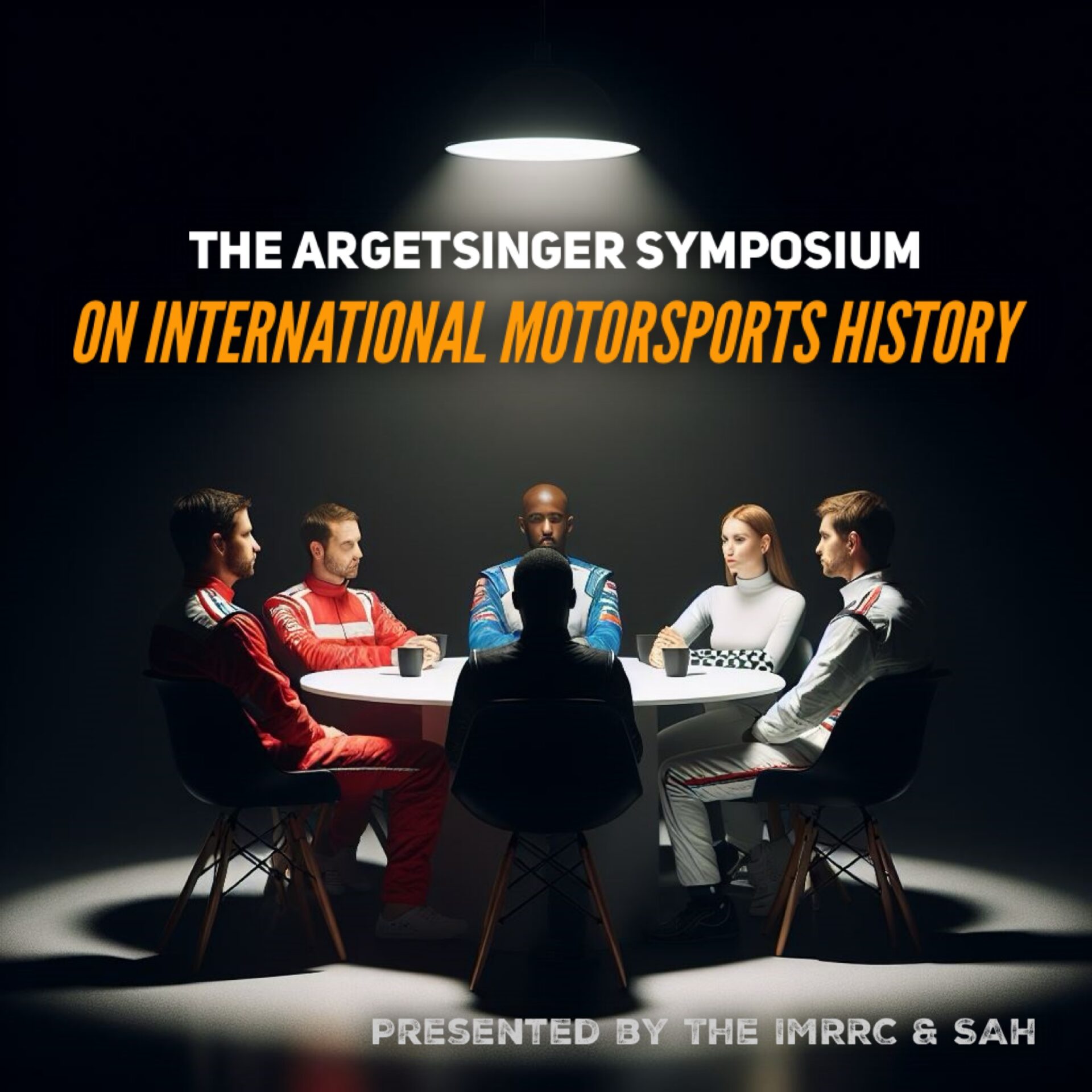 The International Motor Racing Research Center (IMRRC), partnering with the Society of Automotive Historians (SAH), presents the annual Michael R. Argetsinger Symposium on International Motor Racing History. The Symposium established itself as a unique and respected scholarly forum and has gained a growing audience of students and enthusiasts. It provides an opportunity for scholars, researchers and writers to present their work related to the history of automotive competition and the cultural impact of motor racing. Papers are presented by faculty members, graduate students and independent researchers.The history of international automotive competition falls within several realms, all of which are welcomed as topics for presentations, including, but not limited to: sports history, cultural studies, public history, political history, the history of technology, sports geography and gender studies, as well as archival studies.
The International Motor Racing Research Center (IMRRC), partnering with the Society of Automotive Historians (SAH), presents the annual Michael R. Argetsinger Symposium on International Motor Racing History. The Symposium established itself as a unique and respected scholarly forum and has gained a growing audience of students and enthusiasts. It provides an opportunity for scholars, researchers and writers to present their work related to the history of automotive competition and the cultural impact of motor racing. Papers are presented by faculty members, graduate students and independent researchers.The history of international automotive competition falls within several realms, all of which are welcomed as topics for presentations, including, but not limited to: sports history, cultural studies, public history, political history, the history of technology, sports geography and gender studies, as well as archival studies.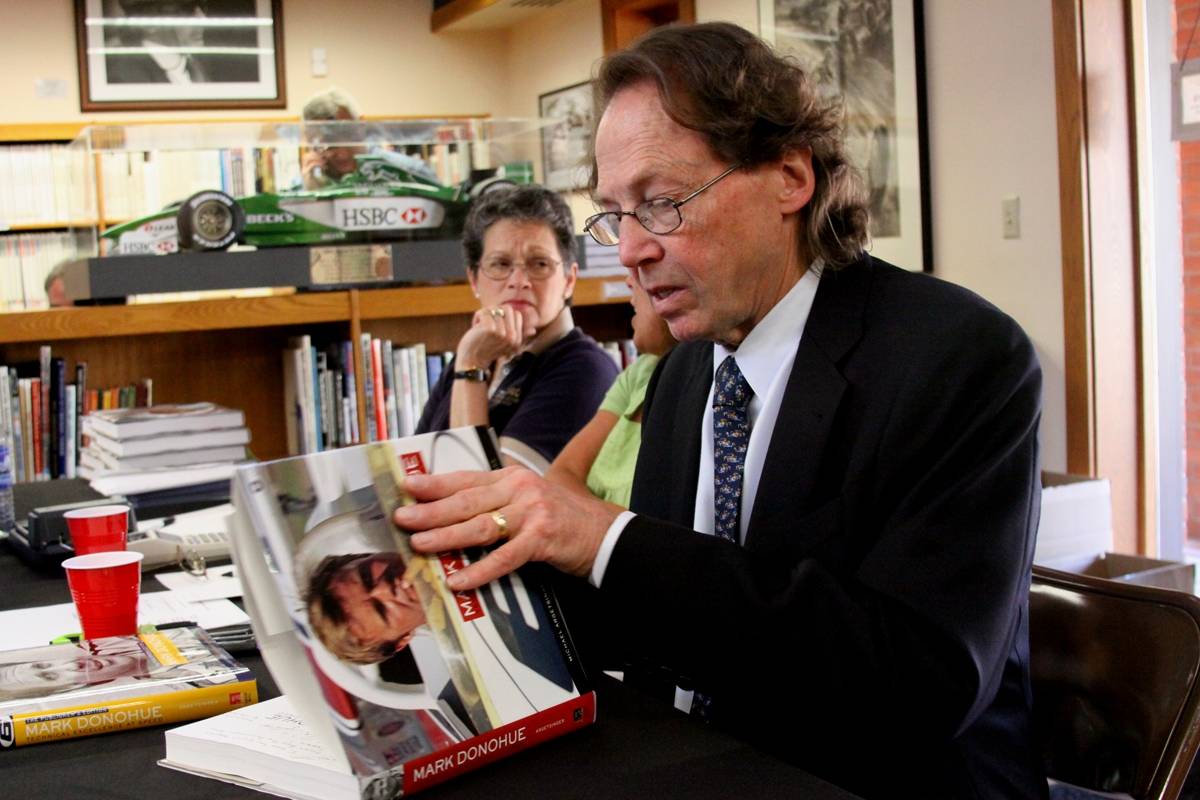 The symposium is named in honor of Michael R. Argetsinger (1944-2015), an award-winning motorsports author and longtime member of the Center's Governing Council. Michael's work on motorsports includes:
The symposium is named in honor of Michael R. Argetsinger (1944-2015), an award-winning motorsports author and longtime member of the Center's Governing Council. Michael's work on motorsports includes:


